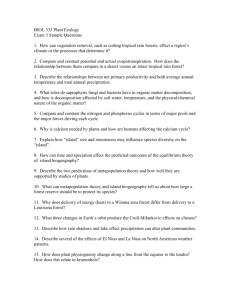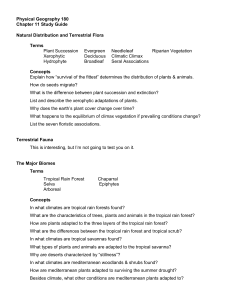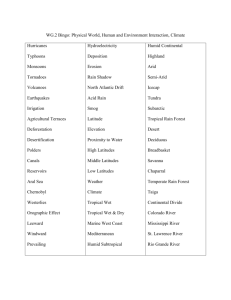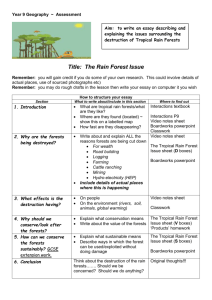This is a perfect environment for decomposition.
advertisement
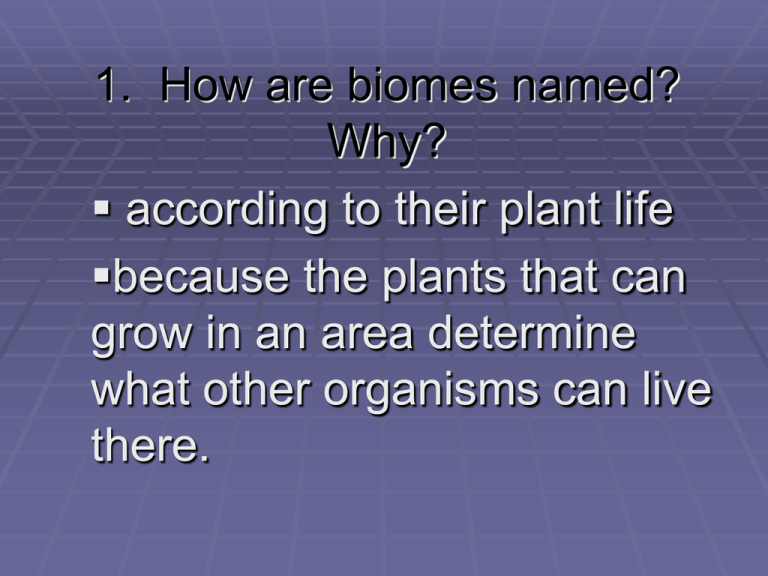
1. How are biomes named? Why? according to their plant life because the plants that can grow in an area determine what other organisms can live there. 2. What determines which plants can grow in a certain area? climate 3. What is climate? the weather conditions in an area over a long period of time 4. What are the 2 most important factors in a region’s climate? temperature and precipitation 5. Where do tropical rain forests occur? in a belt around the Earth, near the equator 6. Tropical rain forests are always humid and warm and get about how much rainfall a year? 250 cm (100in) 7. Since tropical rain forests are near the equator, they get strong sunlight year-round, maintaining what type of climate? one with little seasonal variation 8. How are the World’s rain forests characterized? by heavy rainfall and fairly constant warm temperatures year-round This is a perfect environment for decomposition. 9. What is a humid and warm environment perfect for growing? plants 10. Do tropical rainforests have more or less diversity of species than any other biome? more 11. You would think that this profusion of plants grows on rich soil, but that is not so. Why? Rapid decay of plants and animals returns nutrients to the soil, but these nutrients are just as quickly picked up by the plants and what nutrients remain are washed away by rainfall. 12. What type of soil do tropical rain forests have? Does it support much undergrowth? thin and poor, no 13. In tropical rain forests, how do plants grow? in layers 14. What percentage of sunlight does the upper canopy in rain forests absorb? 95% 15. What type of plants grow in the understory? small trees and shrubs adapted to shade 16. What does it mean when we say that all rain-forest animals are specialists? Each is adapted to exploit a specific resource in a particular way to avoid competition. 17. Is camouflage common or uncommon in the rainforest? common 18. Tropical rain forest used to cover about how much of the earth’s surface? 20% 19. Today they cover about how much? 7% 20. Where is the only temperate rain forest in North America? the Pacific Northwest 21. What characterizes a temperate rain forest? a. trees covered with mosses and lichens b delicate ferns on the forests floors c. towering evergreen trees d cool and humid 22. Why does American temperate rain forest never freeze even though it is located at about 50 to 60 degrees north latitude? nearby Pacific Ocean waters moderate the temperature 23. What characterizes trees in temperate deciduous forests? trees drop their broad flat leaves each fall 24. How would you describe the seasonal variations? extreme -the growing season lasts only four to six months 25. What makes the soil rich and deep? Rain and snow aid in the decomposition of dead organic matter, such as fallen leaves, and make the soil rich and deep. 26. Describe the three main layers of a temperate deciduous forest. a. forest canopy is dominated by tall trees such as maple, pecan, elm, pine b. smaller trees, shrubs and bushes abound in the understory c. the forest floor gets more light than that of a rain forest, and more plants - ferns, herbs, and mosses grow there as a consequence. 27. How have temperate forest plants adapted to survive seasonal changes? During cold weather; -trees shed their leaves -plants become dormant During warm weather; -growth occurs 28. How and what animals have adapted to the different layers? a. squirrels eat nuts, seeds and fruits in the treetops b. bears eat the leaves and sweet berries of forest plants c. deer and other browsers eat leaves from trees and 29. How have birds, mammals and insects adapted to their varied seasonal environments? a. birds migrate b. mammals hibernate c. insects enter a state of very low metabolic activity 30 Describe the climate in a taiga forest. a. winters are long (6 to 10) months and extremely cold b. the growing season may be as short as 50 days 31. Describe a conifer. a tree whose seeds grow in cones most do not shed their needleshaped leaves cone shaped 32. What are some plant adaptations? a. do not usually shed leaves (helps them to survive harsh winters) b. leaves’ narrow shape and waxy coating retain water for the tree when the moisture in the ground is frozen c. the typical cone shape helps to shed snow whose weight would otherwise crush it 33. How have animals adapted to a taiga forest? a. birds migrate b. rodents burrow underground c. the hare’s fur changes from brown in summer to white in winter d. mammals have thick fur 34.Where can the greatest collection of grazing animals be found along with the magnificent predators that hunt them? Tropical savannas 35. Where are tropical savannas found? In the tropics near the equator. 36. Why are there few trees growing in a tropical savanna? They occur inland so they get too little rain for trees to grow. 37. What may sweep across the savanna during dry season? fires 38. State three plant adaptations in tropical savannas and the reason they have adapted this way. Large underground root systems to survive fire so plants re-grow quickly after a fire Grasses have vertical leaves that further help them conserve water. Trees and shrubs have thorns or razor-sharp leaves that deter hungry herbivores 39. State three animal adaptations in tropical savannas and the reason they have adapted this way. a. large, grazing herbivores have adopted a migratory way of life; they follow the rains to areas of newly sprouted grass b. Animals give birth only during the rainy season, when food is most abundant and the young are more likely to survive c. Herbivores avoid competition for food by eating vegetation at different heights. 40. Describe the soil of grasslands. Very fertile 41. Most grasslands have been replaced by what? Grain crops 42. Where are temperate grasslands found? In the interior of continents where there is too little rainfall for trees to grow. 43. Other than the prairies in America, what are two other types of grasslands and where are they located? Steppes – Russia and Ukraine Pampas – south America 44. Describe how plants are adapted to grasslands and give a reason for this Their root system form dense mats that survive drought and fire and hold the soil in place 45. What are two of the biggest threats to temperate grasslands? a. Cultivation b. overgrazing 46. What are deserts defined as? Areas that receive less than 25 cm of precipitation a year 47. What do mountains have to do with deserts? Mountains sometimes block the passage of rain, creating a “rain shadow” where deserts form 48. Why is the soil in desserts rich is minerals, but poor in organic matter? Because deserts get so little rainfall, few nutrients are washed out of the soil, but the dryness also hinders decay of dead organic natter. Thus the soil is rich in minerals, but very poor in organic matter. 49. Adaptations for what characterize all desert plants? Adaptations for getting and conserving water 50. What are three examples of desert reptiles and what do they have to prevent water loss? Reptiles – dry, scaly skin Amphibians – estivation (burying themselves in the ground and sleeping through the dry season. Insects – body armor that helps them retain water. 51. How do amphibians survive scorching desert summers? How does this help Estivating – burying themselves in the ground and sleeping through the dry season. 52. What are some threats to deserts? Residential developments 53. Where is tundra located? North of the arctic circle 54. Summers are short in the tundra so how much of the soil is able to thaw? Only the top few inches of soil thaw 55. Since only the top few inches in the tundra thaw, the surface during the warm months contain many bogs and swamps. This is perfect for what? Swarming insects – mosquitoes & blackflys 56. How have animals adapted to the tundra? Migration Burrowing underground during winter White fur Insulation Shaggy coats 57. What is a characteristic of the tundra that makes it susceptible to damage? It is the most fragile biome on the planet 58. How would you describe the food chains in the tundra? Delicate and easily disrupted 59. Because conditions are so extreme how would you describe the lands vulnerability? The land is easily damaged and slow to recover 60. What has been lately the biggest concern/threat to the tundra? humans 61. DELETE

